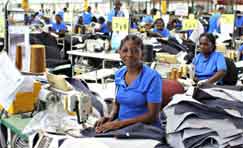Levi’s may be known for its blue denim and jeans, but now it wants customers to know there is a lot of green in its supply chain as well.
The San Francisco-based company has now vowed to reduce CO2 emissions from its supply chain 40% by 2025, on top of plans to use 100% renewable energy in all of its own facilities and cut emissions in those buildings by 90% compared to Levi’s footprint in 2016.
To reach the supply chain emissions reduction target, Levi's will obviously have to work closely with suppliers in its almost totally outsourced supply chain, since it can't just set mandates and hope to get compliance.
"The supplier side of this is what I would consider the most interesting part of our new approach to climate change," Michael Kobori, vice president of social and environmental sustainability at Levi’s, recently told Fast Company magazine.
The company's retail stores, distribution centers, offices, and the two remaining factories it still owns only account for 1% of its total carbon footprint, while growing cotton is responsible for 10%. But making fabric and sewing clothing, respectively, are 31% and 9%. Without working with suppliers, the company is obviously limited in the amount of its emissions it can reduce.
However, persuading suppliers – most of which for Levi’s are offshore - to take emission reduction seriously is a challenge.
“It’s much easier to say ‘for our own facilities we’re going to get to 90%,’ and then they just hold themselves accountable,” Mindy Lubber, CEO and president of Ceres, a sustainability nonprofit that has worked with Levi’s, again told Fast Company. “I think you have to be more clever, more creative, more entrepreneurial, to get your suppliers to do it, because you don’t own them, and while you have an economic incentive for them to do it, you can’t make them do it.”
A 40% emissions reduction of supplier emissions, she says, is an ambitious goal, and one that hasn’t been attempted by any other company.
But Levi’s believes reaching such an ambitious target it is possible. It initially conducted a pilot program with six suppliers. While those projects targeted only “only the low-hanging fruit,” according to Levi’s Kobori, the initiatives still generated significant decreases in in energy use.
A recent pilot with one supplier in Bangladesh resulted in a 20% reduction in CO2 and $1 million in energy savings.
 Levi’s says it will now also work with suppliers to assess the possibility of shifting to renewable energy, and will work with an outside organization – an arm of the World Trade Organization - to help finance on-site renewables when that makes economic sense. It will also expand the program to work with both final assembly factories and textile mills. Levi’s says it will now also work with suppliers to assess the possibility of shifting to renewable energy, and will work with an outside organization – an arm of the World Trade Organization - to help finance on-site renewables when that makes economic sense. It will also expand the program to work with both final assembly factories and textile mills.
Levi’s is also trying to find ways to get customers into the CO2 reduction mix, as consumers create about one-third of Levi’s total emissions across the full product lifecycle.
Apparel care tags, for example, in most of the company’s clothing say “wash less, wash cold, line dry, donate when no longer needed,” as laundry is one of the biggest areas of consumer-generated CO2. Levi’s also recommends that its retail channel partners offer tailor services in stores for repairing jeans so they last longer.
For Levi’s, that is certainly putting its money where its mouth is.
The company also believes it is the first US apparel company to set targets under the Science Based Targets Initiative.
Any reaction to this Levi's CO2 Reduction Plan? Let us know your thoughts at the Feedback button below.

|